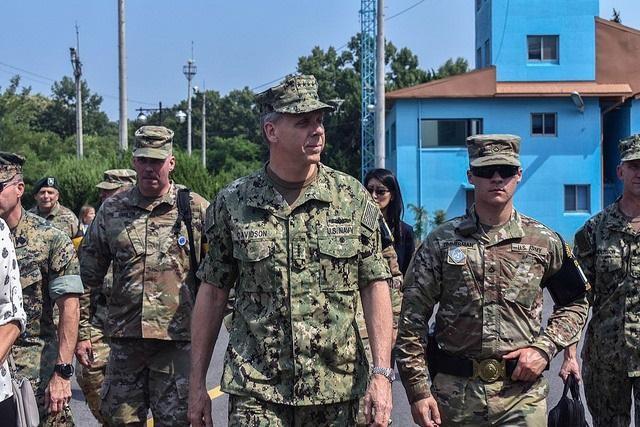Up close with the man tasked to implement US' military policy in South China Sea
Editor's Note: Admiral Philip Davidson faced the media for the first time recently on his 7th week as the new commander of the Indo Pacific Command. GMA News' Chino Gaston was there.
When journalists covering the 2018 Rim of the Pacific Exercises were told we were meeting with the US Indo-Pacific Command commander Admiral Philip Davidson, I considered it a rare opportunity to meet the man tasked to implement America’s military policy in the South China Sea.
We were told the meeting could not be recorded and that a transcript of the round table discussion would be provided at a later date.
Security was understandably tight as we entered the PACOM Compound in Honolulu.
No electronic equipment was allowed inside the building.
The US Pacific Command had direct control over all US forces in its area of operations which ranged from the Indian Ocean all the way to the Pacific side of North and South America.

From this perspective, the security protocol started to make sense given all the security concerns in the region.
We were led into the lobby, past Navy memorabilia and into two elevators with strict orders to take the same elevators after the meeting was adjourned.
The briefing room had two long tables with specific seating arrangements. You were to sit at the chair where a nameplate bearing your name was placed facing the seat of Admiral Davidson.
A large seal of the Pacific Command dominated one wall while a small watercolor painting of the latest stealth submarine hung from a wall to the commander’s right.
Admiral Davidson entered the room clad in military uniform, his tall dominating frame a contrast to his slight, somber smile.
He shook hands with all the journalists in the room, making his way around the two tables and taking your hand with a firm although easy grip.
After a brief statement on the objectives of the ongoing Rim of the Pacific Exercises as well as the common interests shared by the participating countries, Davidson took our questions.
An eye on China
It was no surprise that the first question was about the perceived belligerence of China in the Indo-Pacific Region.
Davidson admits there were some aspects of Chinese behavior in the region that was a matter of concern for the United States.
“There are areas in which China is trying to supplant the United States and our interests in the region. They’re exercising some coercive economic practices in the region as well," he said.
The US, Davidson said, is quite clear on the environment it wants to maintain in the region.
“We have made it quite plain that our interest is in a free and open Indo-Pacific as opposed to some alternative structure that is rather opaque," he said.
Previously, the US came under fire from some of its allies for not doing enough in the region to stem Chinese aggression, particularly in the disputed areas of the South China Sea.
China had built artificial islands on disputed waters in the South China Sea and was recently reported to have put missile and electronic jamming systems as well.
Fishermen from the Philippines have reported harrasment from Chinese Coast Guard personnel in one form or another in recent months, particularly at the Scarborough Shoal (Panatag Shoal).
China disinvited to RIMPAC 2018
As a consequence of China reneging on its promise not to militarize the artificial islands, US Pacific Command and the US State Department retracted the standing invitation to China for this year's RIMPAC exercises.
"The Chinese promised they would not militarize those outposts in the South China Sea. And in April it became evident that they had moved arms directly there; so that was the reason for the disinvite here to RIMPAC," Davidson said.
Upon the invitation of the US, China became a participant in the 2014 and 2016 RIMPAC exercises.
They were scheduled to attend this year's exercises until they were disinvited early this year.
Chinese spy ship
Invited or not, China still managed to have its presence felt at RIMPAC.
Davidson confirmed that a Chinese surveillance ship was in the area observing the exercises.
Reports coming from the US Naval Institute identified the vessel as a Dongdiao class auxillary general intelligence ship.
This was the same ship the Chinese People's Liberation Army Navy sent to RIMPAC in 2014 and 2016.
"The Chinese have an intelligence gathering ship close by, and we're monitoring it continuously throughout the exercise. So we ... Many nations have intelligence gathering ships. They've got access to these global commons as well, so we know where they are, and they're monitoring the exercise," said Davidson.
Challenges faced in the region
Davidson said peace and stability in the region are shared interests of all nations in the Indo-Pacific where trillions of dollars worth of trade regularly passes through every year.
Keeping the trade routes safe and free is a priority not only of the US but all countries.
Without naming China in particular, Davidson outlined the biggest challenge facing his command.
"A challenge from a country that runs an authoritarian and closed internal order, how that would function in an international environment escapes me. I think it's important that the free and open nations that you guys all represent with us continue to advance this order for, again, our mutual security, our interests, economic interests, and our values," he said.
Davidson however did not rule out future cooperation with China in the region saying both superpowers had common interests as well. —KG, GMA News



